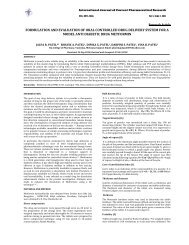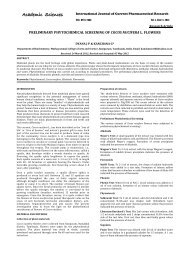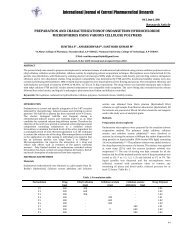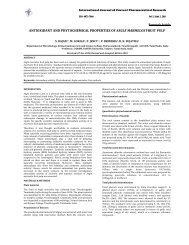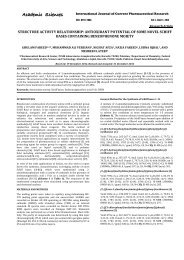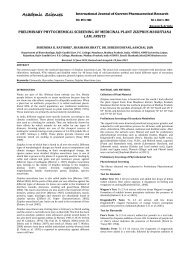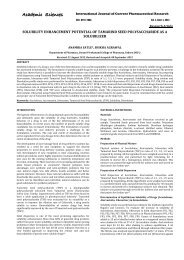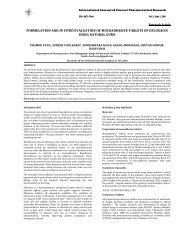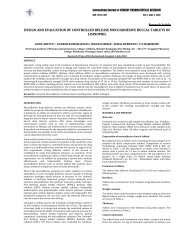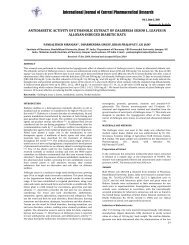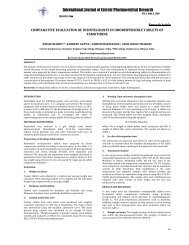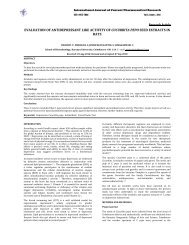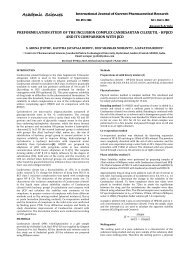preparation and characterization of modified starch isolated
preparation and characterization of modified starch isolated
preparation and characterization of modified starch isolated
You also want an ePaper? Increase the reach of your titles
YUMPU automatically turns print PDFs into web optimized ePapers that Google loves.
International Journal <strong>of</strong> Current Pharmaceutical Research<br />
ISSN- 0975-7066 Vol 3, Issue 2, 2011<br />
Research Article<br />
PREPARATION AND CHARACTERIZATION OF MODIFIED STARCH ISOLATED FROM<br />
AMARANTHUS PANICULATUS LINN.<br />
SINGH L. 1* , SHARMA V. 1 , SHARMA S. 2<br />
Division <strong>of</strong> pharmaceutical technology, Department <strong>of</strong> pharmacy, SRMSCET, Bareilly, Uttar Pradesh, India 1 , Department <strong>of</strong> pharmacy,<br />
Vivek College <strong>of</strong> technical education Bijnor Uttar Pradesh, India 2 Email: lalit4u78@gmail.com<br />
Received: 04 Nov 2010, Revised <strong>and</strong> Accepted: 06 Dec 2010<br />
ABSTRACT<br />
A study has been carried out to investigate the binding <strong>and</strong> disintegrating properties <strong>of</strong> <strong>modified</strong> <strong>starch</strong>, <strong>isolated</strong> form Amaranthus paniculatus Linn<br />
(Amaranthaceae). (Amaranth <strong>starch</strong>) .After modifications <strong>of</strong> Amaranth <strong>starch</strong> (MAS) dissolution pr<strong>of</strong>iles were studied. Paracetamol (500 mg) was<br />
used as a marker drug <strong>and</strong> dissolution data <strong>of</strong> MAS compared with explotab (marketed <strong>modified</strong> potato <strong>starch</strong>) (ES) <strong>and</strong> potato <strong>starch</strong> (PS) in<br />
batches <strong>of</strong> 200. All the products met the requirement <strong>of</strong> in vitro parameters like uniformity <strong>of</strong> weight, assay, friability <strong>and</strong> hardness as per<br />
pharmacopoeial requirements. These product also conform the dissolution specification <strong>of</strong> USP. The amount <strong>of</strong> <strong>modified</strong> Amaranth <strong>starch</strong> (MAS)<br />
required as binding <strong>and</strong> disintegrating agent was three fourth <strong>of</strong> the amount <strong>of</strong> maize <strong>and</strong> potato <strong>starch</strong>. Therefore <strong>modified</strong> Amaranth <strong>starch</strong> can be<br />
effectively used in tablet technology.<br />
Keywords: Modified Amaranth <strong>starch</strong>, maize <strong>and</strong> potato <strong>starch</strong><br />
INTRODUCTION<br />
Amaranthus paniculatus linn. (family amaranthaceae) is commonly<br />
known as `rajgira’, ` rajagiri’ the amaranthaceae family consists <strong>of</strong><br />
hardy, weedy, herbaceous, fast growing, cereal‐like plants, with a<br />
seed yield <strong>of</strong> up to 3 tons/hectare.<br />
Amaranth belongs to the so‐called improper cereals (pseudocereals)<br />
<strong>and</strong> called the third millennium crop‐plant due to its high<br />
nutritional value <strong>and</strong> modest dem<strong>and</strong>s at growing.<br />
For its features amaranth is important as prevention for people <strong>of</strong> all<br />
ages. Lysine has a unique meaning for small children (it supports<br />
the production <strong>of</strong> brain cells) <strong>and</strong> minerals, vitamins, unsaturated<br />
fatty acids, quality protein for sportsmen, which support the growth<br />
<strong>of</strong> muscular matter. Amaranth recovers cells <strong>and</strong> influences<br />
metabolism significantly.<br />
Amaranth grains contain 7% <strong>of</strong> oil, where a high portion <strong>of</strong> essential<br />
fatty linoleic acid (70% unsaturated fatty acids) <strong>and</strong> essential<br />
squalene (6.5%) is present high protein content (17%) gluten free,<br />
dietary fiber (1.5%) <strong>and</strong> high contact <strong>of</strong> minerals (Ca, K, P, Fe) put<br />
amaranth on remarkable place in comparison to the other plants.<br />
Although a large number <strong>of</strong> disintegrants <strong>and</strong> binders are available.<br />
Starches have an important place in the technology <strong>of</strong> tablets.<br />
Usually maize <strong>starch</strong> is used abundantly. But there is always enough<br />
space for developing newer agents to be used in tablet technology<br />
for better result. In view <strong>of</strong> this the present study was carried out for<br />
isolation, modification <strong>and</strong> <strong>characterization</strong> <strong>of</strong> <strong>starch</strong> from<br />
Amaranthus paniculatus .Studies on optimization <strong>of</strong> condition for<br />
carboxymethylation <strong>of</strong> amaranth <strong>starch</strong> has been reported earlier by<br />
Bhattacharya et al 1 .<br />
MATERIAL METHODS<br />
Plant material<br />
Well identified seeds <strong>of</strong> Amaranthus paniculatus were collected<br />
from local market, Bareilly.Seeds were identified according to the<br />
description <strong>of</strong> the Wealth <strong>of</strong> India (Council <strong>of</strong> Industrial <strong>and</strong><br />
Scientific Research, Government <strong>of</strong> India, New Delhi, 1985) <strong>and</strong><br />
macroscopic comparison was done for authentification <strong>of</strong> the<br />
samples at laboratory <strong>of</strong> College, where a voucher specimen is<br />
deposited.<br />
Isolation procedure<br />
The grains <strong>of</strong> Amaranthus paniculatus were thoroughly washed with<br />
water to remove any dirt or adherent material. The grains ware<br />
then dried <strong>and</strong> coarsely ground in a mixer grinder <strong>and</strong> passed<br />
through 22‐mesh sieve. These coarsely ground grains were<br />
extracted repeatedly with 0.25% sodium hydroxide in a ratio <strong>of</strong> 1:5,<br />
until seeds became free from proteins(tested with Biuret reagent).<br />
The protein free grains were washed continuously for 2 hrs with<br />
distilled water till free from sodium hydroxide <strong>and</strong> proteins. The<br />
residue was transferred to the grinder <strong>and</strong> ground with water to<br />
obtain a white paste <strong>of</strong> <strong>starch</strong> <strong>and</strong> fiber. Filtration was done through<br />
bolting cloth <strong>of</strong> 200‐mesh size. Filtrate was collected <strong>and</strong> kept for<br />
sedimentation. The sediment obtained was subjected to<br />
centrifugation at 6000 rpm for 15 min. The upper brownish layer<br />
was scraped <strong>and</strong> remaining white layer was transferred in the tray<br />
dryers <strong>and</strong> dried at 45 0 C for 5hrs. The dry <strong>starch</strong> obtained was<br />
passed through 60 mesh.<br />
Modification <strong>of</strong> <strong>isolated</strong> <strong>starch</strong> 1<br />
Sodium carboxy methyl <strong>starch</strong> (CMS) is prepared by the reaction <strong>of</strong><br />
<strong>starch</strong> with sodium monochloroacetate in presence <strong>of</strong> sodium<br />
hydroxide <strong>and</strong> in presence <strong>of</strong> organic solvent (isopropyl alcohol)<br />
based on Williamson Ether synthesis. And mechanics is essentially<br />
SN2 (Substitution nucleophilic bimolecular).<br />
Starch – OH +Cl CH2 COONa +NaOH Starch ‐ OCH2 COONa +Nacl<br />
+H2O<br />
Starch Sodium monochloro acetate Carboxy methyl <strong>starch</strong><br />
Multistage carboxymethylation <strong>of</strong> the <strong>starch</strong> 1<br />
The second stage carboxymethylation was done <strong>of</strong> the sodium CMS<br />
obtained from first stage as under the same conditions<br />
(requirements) as were in first stage. Similarly third stage<br />
carboxymethylation was carried out using <strong>starch</strong> obtained after<br />
second stage as a raw material but in the third stage, <strong>starch</strong> was<br />
getting gelatinized there for only double modification was done.<br />
Modified <strong>starch</strong> also complies with all the pharmacopoeial<br />
specifications except pH <strong>and</strong> residue on ignition.<br />
Test for granule strength <strong>and</strong> flow property <strong>of</strong> the granules<br />
prepared by <strong>modified</strong> Amaranth <strong>starch</strong><br />
After <strong>preparation</strong> <strong>of</strong> Paracetamol granules with MAS, ES <strong>and</strong> PS<br />
granule strength were measured as method described by Carr et al.<br />
(1965) 2 .<br />
Flowability <strong>and</strong> angular properties <strong>of</strong> the granules were determined<br />
by as described by Train et al. (1958) 3 .
[<br />
Singh et al.<br />
Int J Curr Pharm Res, Vol 3, Issue 2, 6264<br />
Preparation <strong>and</strong> evaluation <strong>of</strong> tablets 4, 5<br />
Paracetamol tablets by using different <strong>starch</strong>es ( MAS, ES, PS) were<br />
prepared by wet granulation method 5 .The tablets <strong>of</strong> 200 batch size<br />
each were punched using single punch machine (Cadmach, U.K). The<br />
weight variation, test for hardness, friability, disintegration time,<br />
uniformity <strong>of</strong> content <strong>and</strong> In–vitro release pattern tests were<br />
performed according to pharmacopoeial specifications.<br />
In –vitro release pattern 6, 7<br />
In‐ vitro release pattern in. phosphate buffer (pH 7.4) were<br />
determined by using apparatus 1 according to USP XXII <strong>and</strong><br />
procedure followed as described in USP XXII Values <strong>of</strong> cumulative<br />
percent drug dissolved at various time intervals were also found out<br />
<strong>and</strong> plotted against time. Values <strong>of</strong> t50 (time for 50% dissolution) <strong>and</strong><br />
t70 (time for 70% dissolution) <strong>and</strong> t90 (time for 90% dissolution)<br />
were determined from this plot.<br />
Statistical analysis<br />
The data were analyzed using non‐parametric Mann‐Whitney U‐test.<br />
The Pearson Chi‐ square test was used for comparing the granule<br />
strength uniformity <strong>of</strong> weight, hardness, dissolution rate between all<br />
the groups where potato <strong>starch</strong> used as a positive control. The data<br />
was expressed as mean ± S.D <strong>and</strong> a p‐ value <strong>of</strong>
Singh et al.<br />
Int J Curr Pharm Res, Vol 3, Issue 2, 6264<br />
RESULTS AND DISCUSSIONS<br />
Formulations <strong>and</strong> manufacturing processes have significant effects<br />
on the disintegration, dissolution <strong>and</strong> other physico‐chemical<br />
characteristics <strong>of</strong> the dosage form. It should be noted however that<br />
the rates <strong>of</strong> the process <strong>of</strong> dissolution are all dependent up on the<br />
composition <strong>and</strong> method <strong>of</strong> <strong>preparation</strong> <strong>of</strong> dosage form 8 .Modified<br />
Amaranth <strong>starch</strong> met the requirement <strong>of</strong> the test for the absence <strong>of</strong><br />
E.coli <strong>and</strong> Salmonella as per pharmacopoeial specifications 9 .The<br />
estimation <strong>of</strong> granule strength is aimed at estimating the relative<br />
magnitude <strong>of</strong> attractive forces seeking to hold the granules together.<br />
The resultant strength <strong>of</strong> granule depends upon the base material,<br />
the kind <strong>and</strong> amount <strong>of</strong> granulating agent used <strong>and</strong> granulating<br />
equipment. Granule strength affects the changes in particle size<br />
distribution <strong>of</strong> granulations <strong>and</strong> consequently compressibility into<br />
cohesive tablets 11 . In case <strong>of</strong> <strong>modified</strong> amaranth <strong>starch</strong>, granule<br />
strengths <strong>of</strong> different formulations as a function <strong>of</strong> granule size are<br />
shown in Table‐2. Several factors <strong>and</strong> granule characteristics have<br />
been studied for their effect on the angle <strong>of</strong> repose, such as, practical<br />
size, use <strong>of</strong> glidant, moisture effect <strong>and</strong> particle shape 10 . In our case<br />
in all the formulations the values for angle <strong>of</strong> repose was less than<br />
30 0 which indicate that the granules prepared with amaranth <strong>starch</strong><br />
as well as other <strong>starch</strong>es used in the formulation were free flowing.<br />
Study <strong>of</strong> the physical parameter <strong>of</strong> the tablets reveals that all the<br />
categories <strong>of</strong> tablets prepared with different <strong>starch</strong>es met the<br />
Pharmacopoeial requirement <strong>of</strong> uniformity <strong>of</strong> weight (I.P.) 9 (Table‐<br />
3).<br />
Values <strong>of</strong> maximum percent deviation were well within the<br />
pharmacopoeial limit. All the products conformed to the<br />
requirement <strong>of</strong> assay (Table‐3) as prescribed in the monograph 9 .<br />
Hardness <strong>of</strong> the tablets was within pharmacopoeial limit (Table‐3)<br />
in all cases. The friability study shows that the friability was with in<br />
the order <strong>of</strong> MAS < MES



